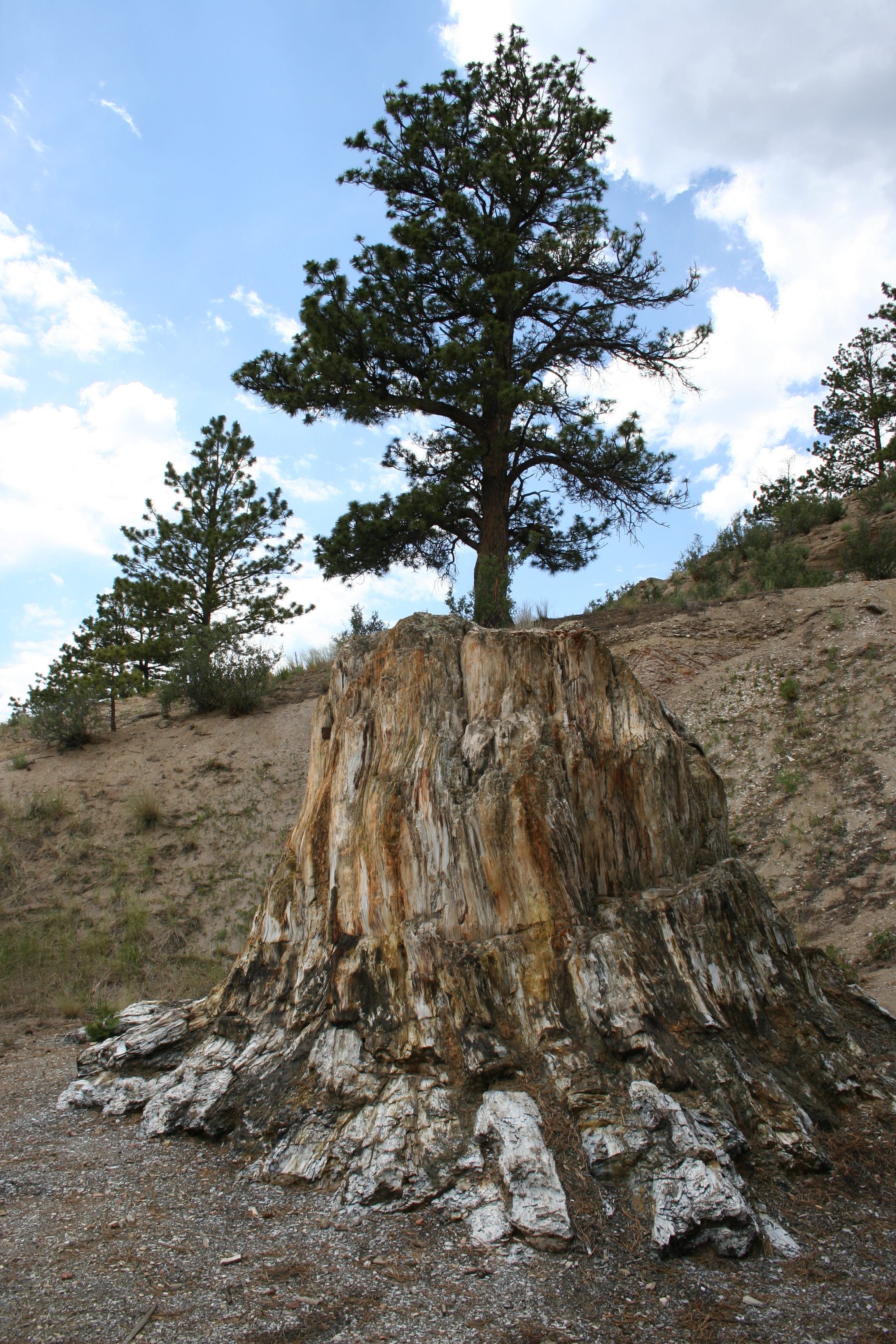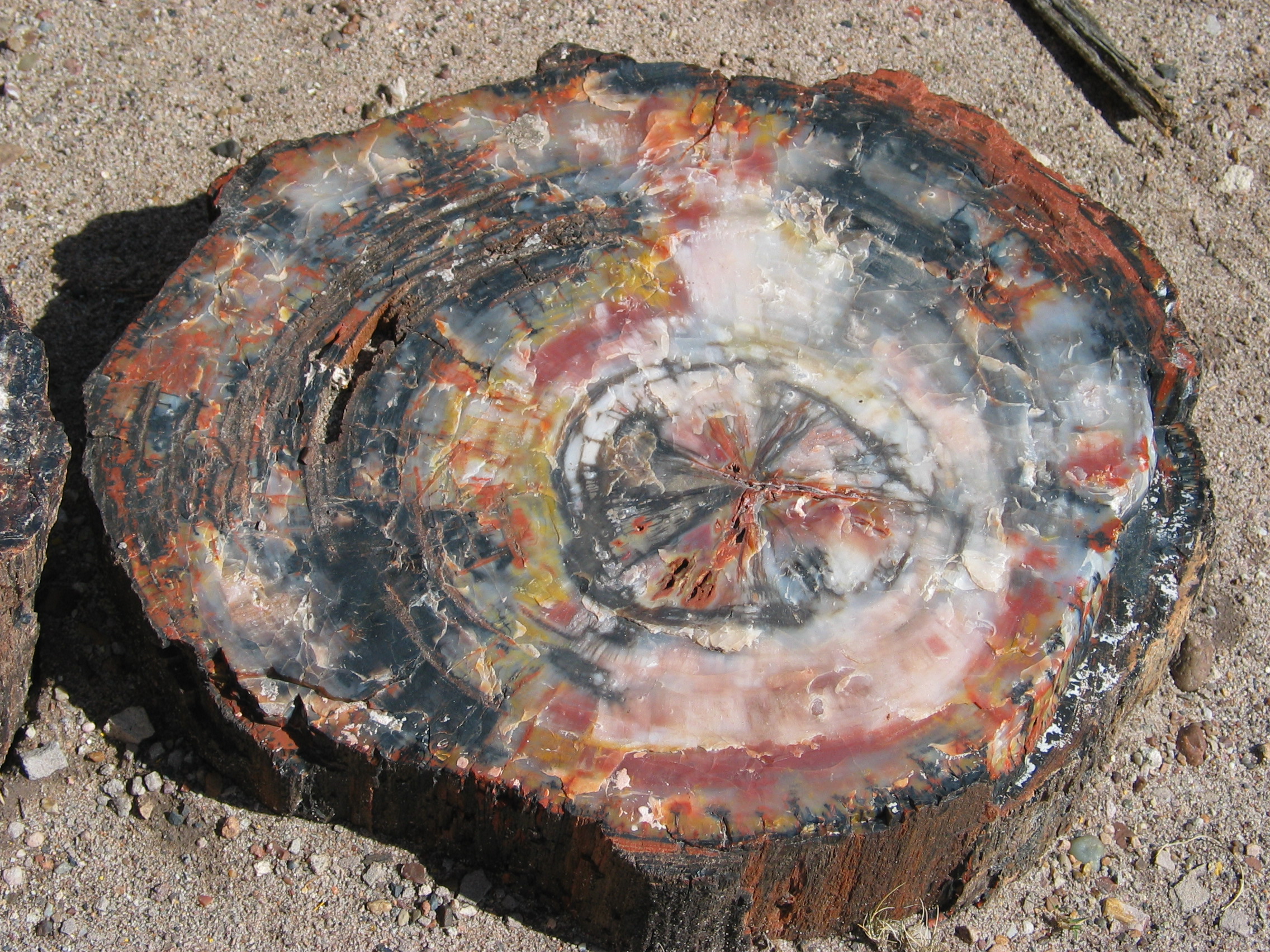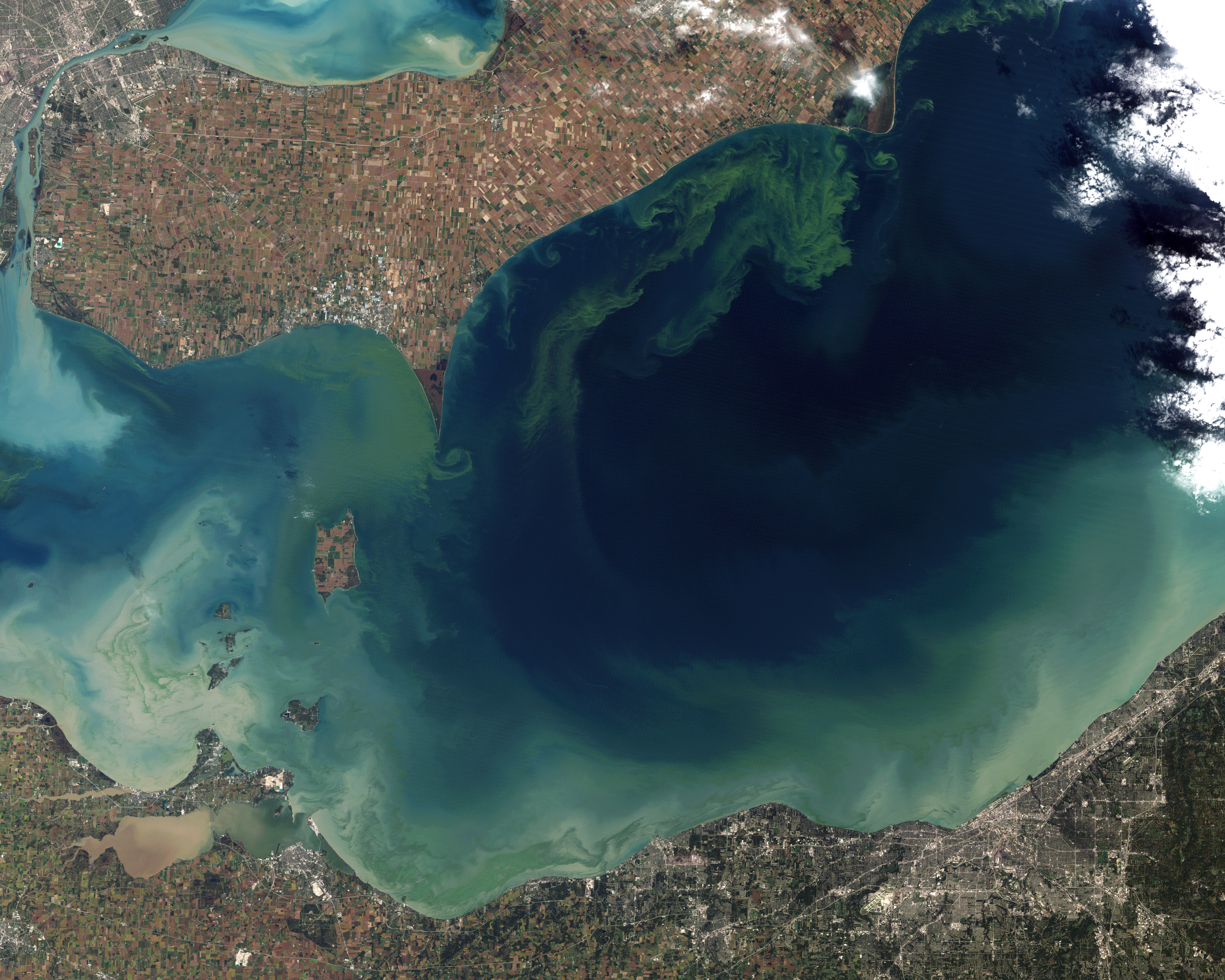|
Florissant Formation
The Florissant Formation is a sedimentary geologic formation outcropping around Florissant, Teller County, Colorado. The formation is noted for the abundant and exceptionally preserved insect and plant fossils that are found in the mudstones and shales. Based on argon radiometric dating, the formation is Eocene (approximately 34 million years old ) in age and has been interpreted as a lake environment. The fossils have been preserved because of the interaction of the volcanic ash from the nearby Thirtynine Mile volcanic field with diatoms in the lake, causing a diatom bloom. As the diatoms fell to the bottom of the lake, any plants or animals that had recently died were preserved by the diatom falls. Fine layers of clays and muds interspersed with layers of ash form "paper shales" holding beautifully-preserved fossils. The Florissant Fossil Beds National Monument is a national monument established to preserve and study the geology and history of the area. History The name ''Fl ... [...More Info...] [...Related Items...] OR: [Wikipedia] [Google] [Baidu] |
Florissant, Colorado
Florissant is an unincorporated town, a post office, and a census-designated place (CDP) located in and governed by Teller County, Colorado, United States. The CDP is a part of the Colorado Springs, CO Metropolitan Statistical Area. The Florissant post office has the ZIP Code 80816. At the United States Census 2020, the population of the Florissant CDP was 128, while the population of the 80816 ZIP Code Tabulation Area was 5,180 including adjacent areas. Etymology Florissant, Colorado, was named after Florissant, Missouri, the hometown of Judge James Castello, an early settler. The word ''florissant'' is the gerund of the French verb ''fleurir'', which roughly means to flourish, to flower, or to blossom. Geography Florissant is located immediately north of Florissant Fossil Beds National Monument. The Florissant CDP has an area of , all land. Demographics The United States Census Bureau initially defined the for the Town Florissant is immediately east of the starting ... [...More Info...] [...Related Items...] OR: [Wikipedia] [Google] [Baidu] |
Charles Whitman Cross
Charles Whitman Cross (September 1, 1854 – April 20, 1949) was an American geologist. He was educated at Amherst College, the University of Göttingen, and Leipzig University. A petrologist, much of his field work concerned rocks in Colorado. He and three other geologists proposed the CIPW norm that is still used in normative mineralogy. He was also active in scientific societies and institutions. Early life and education Cross was born September 1, 1854, in Amherst, Massachusetts, to Maria Mason Cross and the Rev. Moses Kimball Cross. Later his family moved to Waverly, Iowa, where he graduated high school. In 1872 he entered the Scientific Course at Amherst College. After earning a Bachelor of Science degree in 1875, he remained at Amherst doing post-graduate studies in science. He attended the University of Göttingen from 1877 to 1878, when he transferred to Leipzig University. There he studied under Ferdinand Zirkel and earned his Ph.D. in 1880. Career After completing ... [...More Info...] [...Related Items...] OR: [Wikipedia] [Google] [Baidu] |
Petrified Stump P6010834
In geology, petrifaction or petrification () is the process by which organic material becomes a fossil through the replacement of the original material and the filling of the original pore spaces with minerals. Petrified wood typifies this process, but all organisms, from bacteria to vertebrates, can become petrified (although harder, more durable matter such as bone, beaks, and shells survive the process better than softer remains such as muscle tissue, feathers, or skin). Petrifaction takes place through a combination of two similar processes: permineralization and replacement. These processes create replicas of the original specimen that are similar down to the microscopic level. Processes Permineralization One of the processes involved in petrifaction is permineralization. The fossils created through this process tend to contain a large amount of the original material of the specimen. This process occurs when groundwater containing dissolved minerals (most commonly ... [...More Info...] [...Related Items...] OR: [Wikipedia] [Google] [Baidu] |
Algal Bloom
An algal bloom or algae bloom is a rapid increase or accumulation in the population of algae in freshwater or marine water systems. It is often recognized by the discoloration in the water from the algae's pigments. The term ''algae'' encompasses many types of aquatic photosynthetic organisms, both macroscopic multicellular organisms like seaweed and microscopic unicellular organisms like cyanobacteria. ''Algal bloom'' commonly refers to the rapid growth of microscopic unicellular algae, not macroscopic algae. An example of a macroscopic algal bloom is a kelp forest. Algal blooms are the result of a nutrient, like nitrogen or phosphorus from various sources (for example fertilizer runoff or other forms of nutrient pollution), entering the aquatic system and causing excessive growth of algae. An algal bloom affects the whole ecosystem. Consequences range from the benign feeding of higher trophic levels to more harmful effects like blocking sunlight from reaching other organ ... [...More Info...] [...Related Items...] OR: [Wikipedia] [Google] [Baidu] |
Biota (ecology)
A biome () is a biogeographical unit consisting of a biological community that has formed in response to the physical environment in which they are found and a shared regional climate. Biomes may span more than one continent. Biome is a broader term than habitat and can comprise a variety of habitats. While a biome can cover large areas, a microbiome is a mix of organisms that coexist in a defined space on a much smaller scale. For example, the human microbiome is the collection of bacteria, viruses, and other microorganisms that are present on or in a human body. A biota is the total collection of organisms of a geographic region or a time period, from local geographic scales and instantaneous temporal scales all the way up to whole-planet and whole-timescale spatiotemporal scales. The biotas of the Earth make up the biosphere. Etymology The term was suggested in 1916 by Clements, originally as a synonym for '' biotic community'' of Möbius (1877). Later, it gained its c ... [...More Info...] [...Related Items...] OR: [Wikipedia] [Google] [Baidu] |
Florissantia Species Flower
''Florissantia'' can refer to: * ''Florissantia'' (plant), an extinct plant genus in the family Malvaceae * ''Florissantia'' (planthopper), an extinct dictyopharid planthopper insect genus {{Genus disambiguation ... [...More Info...] [...Related Items...] OR: [Wikipedia] [Google] [Baidu] |
Guffey, Colorado
Guffey is a census-designated place (CDP) and post office in and governed by Park County, Colorado, United States. The Guffey post office has the ZIP Code 80820. At the United States Census 2020, the population of the Guffey CDP was 111. The CDP is a part of the Denver–Aurora–Lakewood, CO Metropolitan Statistical Area. History The town was once called Freshwater, and was the center of activity for the Freshwater Mining District, a minor producer of copper, lead, zinc, mica, feldspar, and other minerals, including traces of gold and silver. Activity and population peaked between the years 1895 and 1902, with over 500 residents and 40 businesses in the town. Cattle ranching and lumber operations supplemented the mining activity. The town was also known for its dances and fiddlers. In January 2001, the bodies of three members of the Dutcher family were found near Guffey; all had been murdered. Three teenagers were convicted of the crime. The boys had formed a group that took ... [...More Info...] [...Related Items...] OR: [Wikipedia] [Google] [Baidu] |
Big Stump
Big or BIG may refer to: * Big, of great size or degree Film and television * ''Big'' (film), a 1988 fantasy-comedy film starring Tom Hanks * '' Big!'', a Discovery Channel television show * ''Richard Hammond's Big'', a television show presented by Richard Hammond * ''Big'' (TV series), a 2012 South Korean TV series * '' Banana Island Ghost'', a 2017 fantasy action comedy film Music * '' Big: the musical'', a 1996 musical based on the film * Big Records, a record label * ''Big'' (album), a 2007 album by Macy Gray * "Big" (Dead Letter Circus song) * "Big" (Sneaky Sound System song) * "Big" (Rita Ora and Imanbek song) * "Big", a 1990 song by New Fast Automatic Daffodils * "Big", a 2021 song by Jade Eagleson from '' Honkytonk Revival'' *The Notorious B.I.G., an American rapper Places * Allen Army Airfield ( IATA code), Alaska, US * BIG, a VOR navigational beacon at London Biggin Hill Airport * Big River (other), various rivers (and other things) * Big Island (disam ... [...More Info...] [...Related Items...] OR: [Wikipedia] [Google] [Baidu] |
Cretaceous
The Cretaceous ( ) is a geological period that lasted from about 145 to 66 million years ago (Mya). It is the third and final period of the Mesozoic Era, as well as the longest. At around 79 million years, it is the longest geological period of the entire Phanerozoic. The name is derived from the Latin ''creta'', "chalk", which is abundant in the latter half of the period. It is usually abbreviated K, for its German translation ''Kreide''. The Cretaceous was a period with a relatively warm climate, resulting in high eustatic sea levels that created numerous shallow inland seas. These oceans and seas were populated with now- extinct marine reptiles, ammonites, and rudists, while dinosaurs continued to dominate on land. The world was ice free, and forests extended to the poles. During this time, new groups of mammals and birds appeared. During the Early Cretaceous, flowering plants appeared and began to rapidly diversify, becoming the dominant group of plants across the Earth b ... [...More Info...] [...Related Items...] OR: [Wikipedia] [Google] [Baidu] |
Lahar
A lahar (, from jv, ꦮ꧀ꦭꦲꦂ) is a violent type of mudflow or debris flow composed of a slurry of pyroclastic material, rocky debris and water. The material flows down from a volcano, typically along a river valley. Lahars are extremely destructive: they can flow tens of metres per second, they have been known to be up to deep, and large flows tend to destroy any structures in their path. Notable lahars include those at Mount Pinatubo and Nevado del Ruiz, the latter of which killed thousands of people in the town of Armero. Etymology The word ''lahar'' is of Javanese origin. Berend George Escher introduced it as a geological term in 1922. Description The word ''lahar'' is a general term for a flowing mixture of water and pyroclastic debris. It does not refer to a particular rheology or sediment concentration. Lahars can occur as normal stream flows (sediment concentration of less than 30%), hyper-concentrated stream flows (sediment concentration between 30 and 60% ... [...More Info...] [...Related Items...] OR: [Wikipedia] [Google] [Baidu] |
Lahar
A lahar (, from jv, ꦮ꧀ꦭꦲꦂ) is a violent type of mudflow or debris flow composed of a slurry of pyroclastic material, rocky debris and water. The material flows down from a volcano, typically along a river valley. Lahars are extremely destructive: they can flow tens of metres per second, they have been known to be up to deep, and large flows tend to destroy any structures in their path. Notable lahars include those at Mount Pinatubo and Nevado del Ruiz, the latter of which killed thousands of people in the town of Armero. Etymology The word ''lahar'' is of Javanese origin. Berend George Escher introduced it as a geological term in 1922. Description The word ''lahar'' is a general term for a flowing mixture of water and pyroclastic debris. It does not refer to a particular rheology or sediment concentration. Lahars can occur as normal stream flows (sediment concentration of less than 30%), hyper-concentrated stream flows (sediment concentration between 30 and 60% ... [...More Info...] [...Related Items...] OR: [Wikipedia] [Google] [Baidu] |
Caldera
A caldera ( ) is a large cauldron-like hollow that forms shortly after the emptying of a magma chamber in a volcano eruption. When large volumes of magma are erupted over a short time, structural support for the rock above the magma chamber is gone. The ground surface then collapses into the emptied or partially emptied magma chamber, leaving a large depression at the surface (from one to dozens of kilometers in diameter). Although sometimes described as a Volcanic crater, crater, the feature is actually a type of sinkhole, as it is formed through subsidence and collapse rather than an explosion or impact. Compared to the thousands of volcanic eruptions that occur each century, the formation of a caldera is a rare event, occurring only a few times per century. Only seven caldera-forming collapses are known to have occurred between 1911 and 2016. More recently, a caldera collapse occurred at Kīlauea, Hawaii in 2018. Etymology The term ''caldera'' comes from Spanish language, S ... [...More Info...] [...Related Items...] OR: [Wikipedia] [Google] [Baidu] |







